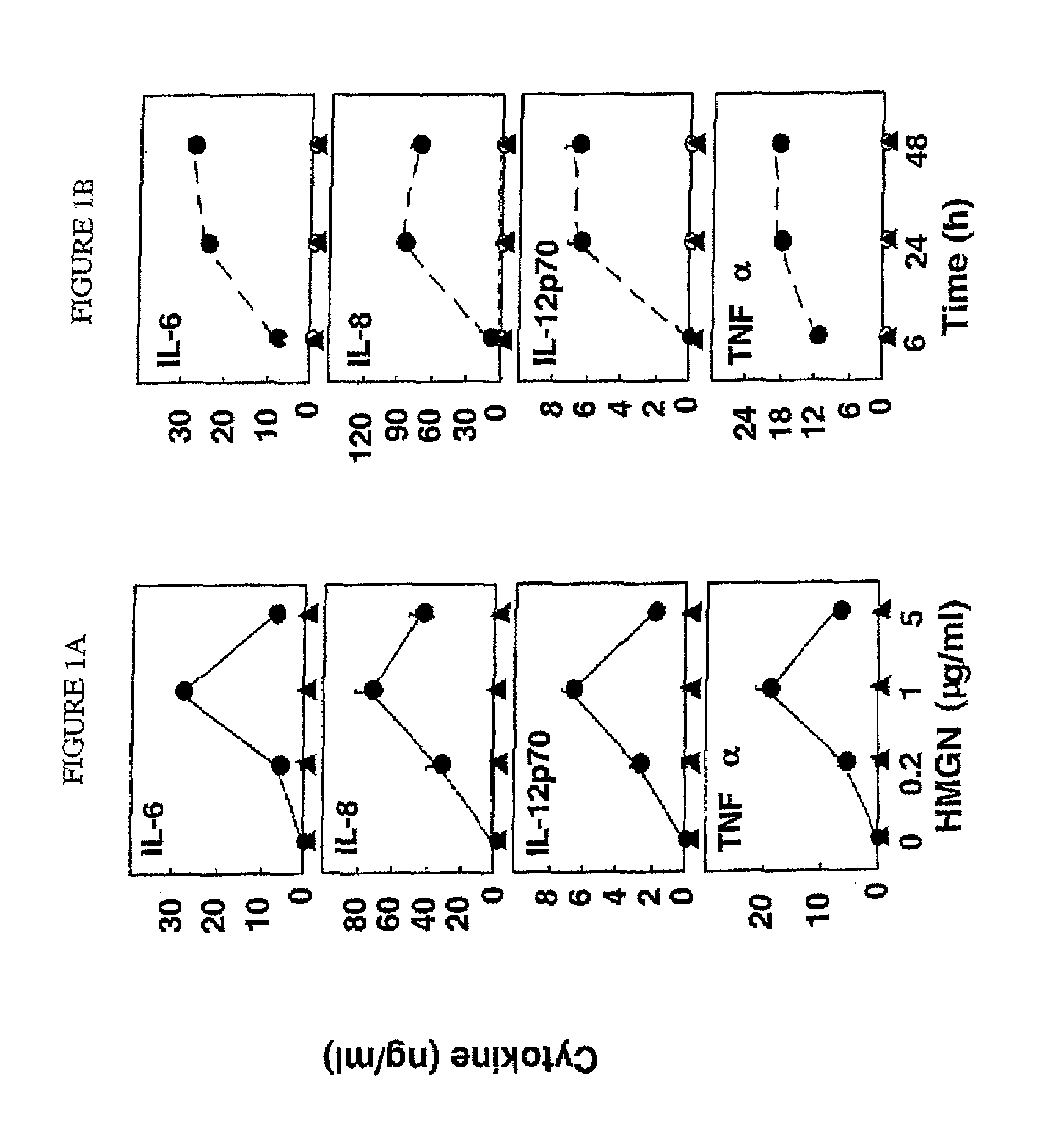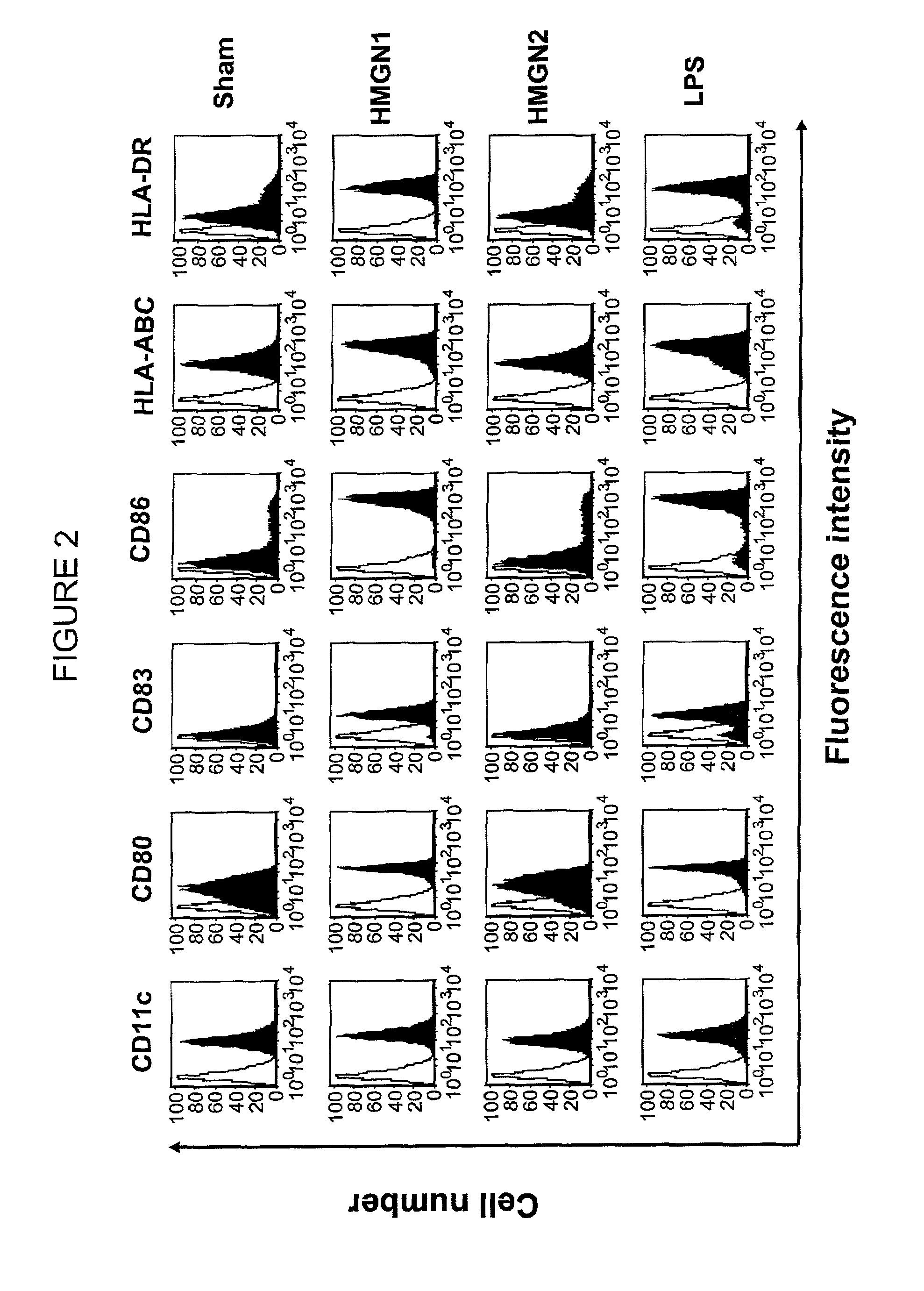HMGN polypeptides as immune enhancers and HMGN antagonists as immune suppressants
a technology of hmgn polypeptides and antigens, applied in the direction of immunological disorders, antibody medical ingredients, peptide/protein ingredients, etc., can solve the problems of reducing the effectiveness of treatment and the immune response of patients, and achieve the effect of enhancing an antigen-specific immune respons
- Summary
- Abstract
- Description
- Claims
- Application Information
AI Technical Summary
Problems solved by technology
Method used
Image
Examples
example 1
[0073]This example demonstrates that HMGN1 (SEQ ID NO: 1) induces dendritic cells to produce cytokines in a dose-dependent manner.
[0074]Human dendritic cells were cultured for 24 hours in RPMI 1640 medium, which contains 10% fetal bovine serum, 50 ng / mL recombinant human (rh) GM-CSF, 50 ng / mL rhIL-4. The cultures were treated with either HMGN1 (SEQ ID NO: 1) or HMGN2 at concentrations of 0, 0.2, 1, or 5 μg / mL. Untreated culture (sham) served as a control. The supernatants of the dendritic cell cultures were assayed for IL-6, IL-8, IL-12p70, and TNFα concentration by cytokine array. Experiments were repeated three times and the average (mean±SD) determined. The results are presented in FIG. 1A.
[0075]As shown in FIG. 1A, HMGN1 (SEQ ID NO: 1) stimulated the production of IL-6, IL-8, IL-12p70, and TNFα in dendritic cells a dose-dependent manner, whereas HMGN2 and untreated cultures showed no significant production of these cytokines. These results support the use of HMGN1 (SEQ ID NO: 1)...
example 2
[0076]This example demonstrates that HMGN1 (SEQ ID NO: 1) induces dendritic cells to produce cytokines in a time-dependent manner.
[0077]Human dendritic cells were cultured for 24 hours in RPMI 1640 medium. The cultures were treated with 1 μg / mL of HMGN1 (SEQ ID NO: 1) or HMGN2, and the supernatents were analyzed by cytokine array for IL-6, IL-8, IL-12p70, and TNFα concentration at 6, 24, and 48 hours. Untreated culture (sham) served as a control. Experiments were repeated three times and the average (mean±SD) determined. The results are presented in FIG. 1B.
[0078]As shown in FIG. 1B, HMGN1 (SEQ ID NO: 1) stimulates the production of IL-6, IL-8, IL-12p70, and TNFα in a time-dependent manner, whereas HMGN2 and untreated cultures showed no significant production of these cytokines. These results support the use of HMGN1 (SEQ ID NO: 1) to activate and / or recruit dendritic cells and enhance an immune response.
example 3
[0079]This example demonstrates that HMGN1 (SEQ ID NO: 1) upregulates dendritic cell expression of surface costimulatory molecules and surface MHC molecules.
[0080]Human dendritic cells were cultured for 48 hours at 37° C. in a CO2 incubator in RPMI 1640 medium. Cultures were treated with 1 μg / mL of HMGN1 (SEQ ID NO: 1) or HMGN2. Culture treated with 1 μg / mL lipopolysaccharide (LPS) and untreated culture (sham) served as positive and negative controls, respectively. The dendritic cells were immunostained and analyzed for the expression of surface molecules by flow cytometry. The results are presented in FIG. 2, wherein open-area curves represent staining with isotype-matched control antibody, and shaded-area curves represent staining with antibodies against the various surface molecules.
[0081]As shown in FIG. 2, treatment with HMGN1 (SEQ ID NO: 1) induces significantly greater expression of costimulatory molecules (CD80, CD83, and CD 86) and MHC molecules (HLA-ABC and HLA-DR) as comp...
PUM
| Property | Measurement | Unit |
|---|---|---|
| concentration | aaaaa | aaaaa |
| concentrations | aaaaa | aaaaa |
| concentrations | aaaaa | aaaaa |
Abstract
Description
Claims
Application Information
 Login to View More
Login to View More - R&D
- Intellectual Property
- Life Sciences
- Materials
- Tech Scout
- Unparalleled Data Quality
- Higher Quality Content
- 60% Fewer Hallucinations
Browse by: Latest US Patents, China's latest patents, Technical Efficacy Thesaurus, Application Domain, Technology Topic, Popular Technical Reports.
© 2025 PatSnap. All rights reserved.Legal|Privacy policy|Modern Slavery Act Transparency Statement|Sitemap|About US| Contact US: help@patsnap.com



